José Franco: "The work of the arrantzales of Euskal Herria has been extraordinary"
All experts agree that, after a spill, it is necessary to collect as many fuels as possible in the sea. Why is it so important to try not to get to the coast?
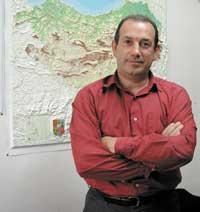
There are many reasons. From a practical point of view, the collection at sea is simpler and cheaper than the withdrawal of certain places on earth, as much less resources and means are needed.
In addition, the impact of fuel on the coast is more pronounced than at sea, and from an environmental point of view, coastal ecosystems are richer and vulnerable, so it is necessary to make an effort to protect them.
On the other hand, time is also important: the faster and closer to the spill, the better. In fact, with time the fuel is emulsified, it takes water and its volume is multiplied by five or six. Then it adheres to other materials that are found in the sea and when it reaches the coast it is necessary to collect twenty percent of the initial volume.
What methods have been used here to collect the fuel poured by the Prestige at sea?
Most of the fuel has been collected through salabardos. We have tried and developed other ways, but since the help of fishermen has been so beneficial and great, finally no other methods have been used, even if they are ready.
After analyzing the favorable and unfavorable factors, it was concluded that the most adequate solution was the collection by salabardos. It should be noted that people have received very well the work of fishermen, that society has shown their solidarity and support to the initiative of fishermen, which has also been a positive factor.
Mention that you have tried other methods of fuel collection. What are those methods?
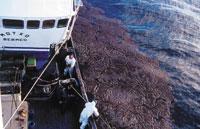
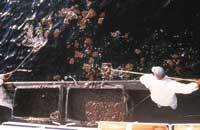
Our work has consisted in adapting the fishing gear so that they are suitable for the collection of fuel and we have tried different systems: rakes, nets of drag... For example, we carried out tests with trawling nets adapted to the height of Santander and collected five tons of fuel. But it became clear that it was not adequate.
To begin with, the fishing gear is adapted to the kind of fish you want to catch. We know what the behavior of the fish is and based on it we elaborate the fishing arts. For example, in the trawling system the fish is collected: the fish is separated from the nets and goes to the centre and the bottom. Finally, all the fish end up collected and tired, and the fisherman takes advantage of it.
In the case of fuel it is not possible. You have to look for a system that filters the water but retains the fuel. The problem is that the fuel adheres to the network as it is introduced through the mouth, so the network is not able to filter the water and is quickly unused. In addition, when climbing the net to the boat everything was dirty and was very expensive. Therefore, we cancel it.
Have you obtained better results with rakes?
Yes, yes, we have seen that the adapted rakes are very effective for the collection of fuel. Tests carried out with the fishing fleet Ozenciyo, dedicated to the collection of algae in the marine bottom of Donostia. The rakes are like frames in which the networks are chained. In this case, the frame had a width of 6 meters and a length of 1.3 meters. Using floats we transform the system to use it in surface. Subsequently, an inner bag made with windbreak materials was placed in this network.
The fishery carries the rake conditioned as normal and collects all the spots found on the road. The sausages are not suitable for the collection of small spots, while the rake collects everything: as the material of the sack is very closed, nothing escapes and at the same time lets filter the water.
In addition, due to water currents, the spots tend to align and the rake, with a width of six meters, collects the entire line. Therefore, we have shown that the system is really effective. When we did the test, the fuel was not very concentrated, but in half an hour we collected five tons of fuel. Therefore, it is assumed that they can be stored between 10 and 20 tons per hour with rake.
Is that not much? How many fuelóleos are collected with salabardos?
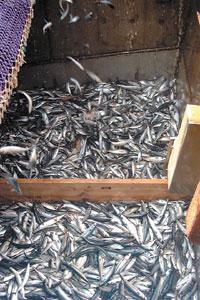
Yes, it's a lot. According to the fishing boat and the crew, a ton is collected per man and on average with salabares, and with rake, besides needing fewer friends, very satisfactory results are obtained. In addition, large fishing vessels such as Ozenciyo, which is 21.3 meters long, are not needed.
As for the cost, it is better than other methods, since it is cheap. The materials are not expensive, the frame and the networks remain in condition to be reused. Once the sack is filled, it closes and beats at sea to be picked up by another boat, or if it is near the coast, it is deposited on the beach and is driven by a truck. Meanwhile, one more bag is placed on the rake, and the fishing boat is still working.
The method is developed. It has not been used since most of the fuel has been collected through salabardos, but sometimes the system is ready.
Some methods tested in other spills, such as bioremediation, solvents, absorbent pumps… here they have not been used, right?
The pumps have been used to absorb the fuel stopped by mobile barriers, but were only installed in certain areas. Once tested the chemical solvents, it has been proven that they are more harmful than beneficial, so here we have not used them. Bioremediation, on the other hand, has been effective in some cases, such as the discharge of Exxon Valdez. In this case, the fuel poured was very biodegradable and with the incorporation into the sea of proliferative agents of bacteria that decomposed it, quite satisfactory results were obtained. The fuel of the Prestige, however, estimated that it biodegradated around 10%, so we discarded this solution.
Practically all the fuel collected at sea has been collected by fishermen. AZTI has mainly collaborated on the monitoring of the spots, the forecasts and the coordination of the fishermen, and the final result has been removable.
Surface rake Surface rake

The surface rake is 6 m wide by 1.30 m long and is formed by a profile U of 10 cm wide. Inside it has a rod to join the network or place the carabiners that support it. The approximate weight is 300 kg and the flotation of complete structures is achieved by two floats of 380 kg of floatability.
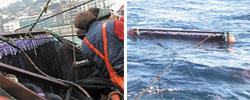
The net is made of polyethylene purpura, of wire of size B/5 with mesh of 50mm. It is like an envelope with frame of 6 m of length and 4 m of width. Inside it has a windbreak type polyethylene bag with two granals, one of them closes the bushing and the other releases it.
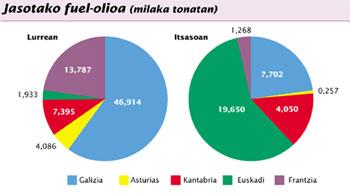
Buletina
Bidali zure helbide elektronikoa eta jaso asteroko buletina zure sarrera-ontzian











